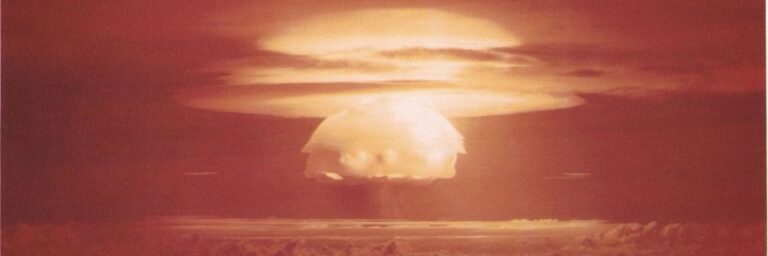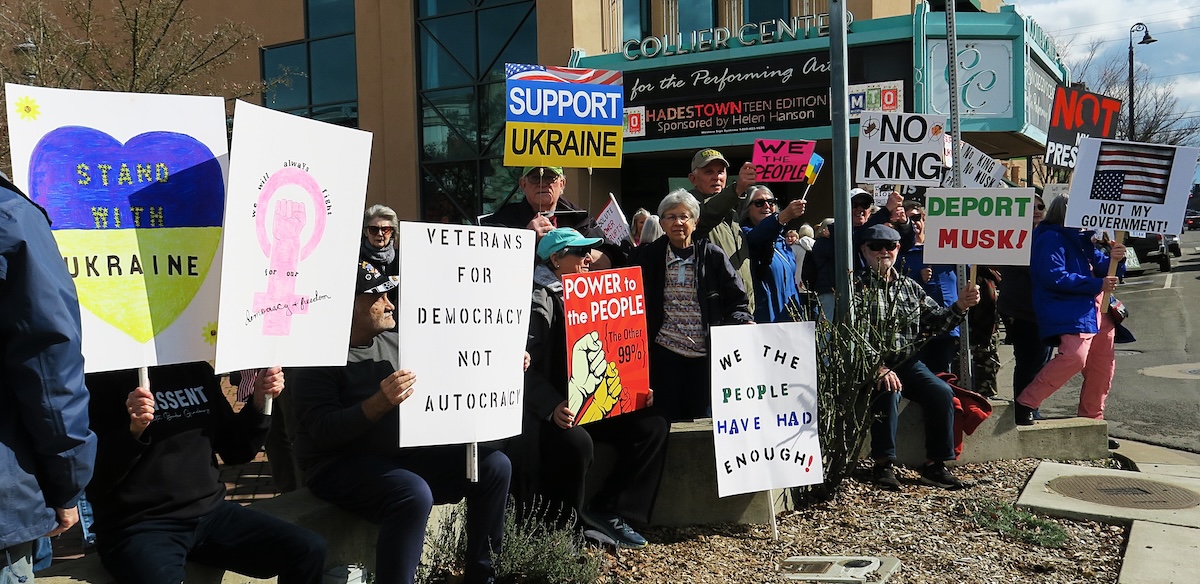We will be reminding the world of the Hibakusha truth that “human beings and nuclear weapons cannot coexist.”
By Joseph Gerson for Common Dreams
Later this month I will return to Japan for the annual Bikini commemoration and the Gensuikyō, or Japan Council Against Atomic and Hydrogen Bombs, annual conference. There won’t be a bikini fashion show.
The commemoration of what can only be called the criminal U.S. Bravo H-bomb test on March 1, 1954, is one of two annual anchor events of the Japanese peace movement. Although Covid-19 is still with us, these events will play important roles in revitalizing the Japanese peace movement; one of the most effective in the world.
Over the years, this movement has played a major role in preventing Japan from becoming a nuclear weapons state, and the testimonies of Hibakusha (victims and witnesses of the A-bombings) have played critical roles in inspiring the nuclear disarmament diplomacy and the international negotiations that resulted in the 2017 United Nations Treaty on the Prohibition of Nuclear Weapons.
Although I initially met several Hiroshima and Nagasaki A-bomb survivors as early as the 1978 U.N. Second Session of Nuclear Disarmament, it wasn’t until I first traveled to Hiroshima in 1984 that I began what became a 40-year engagement with Hibakusha and the Japanese movement.
Bikini Day will be little remarked here in the United States: Cowboys and Indians all over again, and quite literally a case of nuclear colonialism.
In an effort to compensate for his earlier support for the Nuclear Weapons Freeze campaign and to bring nonexistent jobs bacon to Boston, Senator Ted Kennedy (D-Mass.) and, following him, the Massachusetts congressional delegation and the city’s business establishment were suckered into Reagan-administration planning to transform Boston Harbor into a nuclear weapons base. Knowing the Navy’s record of nuclear weapons accidents, the ways that the base would ratchet up tensions with Moscow and violate the freeze, and with knowledge of better economic and social uses for the waterfront property, several of us organized at the grassroots level to prevent construction of the base. We prevailed, and I was invited to give a brief inspirational speech at the World Conference against A- and H- Bombs. Needless to say, my first trip to Hiroshima was a transformative experience.
Not long thereafter, I returned to Japan for the Bikini Day commemorations and was shocked by what I learned from the testimonies of Rongelap and Japanese survivors of the March 1, 1954, Bravo “test.” Bravo was by far the most devastating of the United States’ nuclear weapons explosions that pulverized Bikini between 1946 and 1958. It was detonated a year after the Soviets tested their first H-bomb and two years before a culturally explosive women’s two-piece swimsuit was first marketed in Paris.
Washington responded to the Soviet Union’s first H-bomb with a bomb 1,000 times more powerful than the Hiroshima A-bomb that destroyed an entire city, initially killed 100,000 people—almost all civilians—and poisoned survivors, the environment, and future generations. Ninety-eight miles away from the Bikini H-bomb test site, inhabitants of tropical Rongelap Atoll were showered by and played with radioactive ash that they first thought was snow. Just 500 miles from the equator, they had never seen snow. Japanese fishing boats hundreds of miles from Bikini Atoll and fish that comprised a major portion of Japan’s ocean-based food supply were also irradiated.
Before the year was out, natives of Rongelap and Japanese fishermen began to die from radiation diseases and cancer. Still births and numerous birth defects including jellyfish babies (transparent skin and no bones), anencephaly (infants born without portions of their brain or skull), and other mutations followed.
Secrecy was immediately imposed by both the U.S. and Japanese governments. But as word got out following the return of the Lucky Dragon V tuna fishing boat’s sickened crew to Yaizu City, women with memories of Hiroshima launched a petition campaign for the abolition of nuclear weapons. It garnered 25 million Japanese signatures, leading to the convening of the first World Conference against A- and H- Bombs, which attracted delegates from across Japan and around the world.
Hiroshima and Nagasaki A-bomb victims, many of whom had hidden themselves from the world due to their disfigurements, excruciating physical and emotional pains, and popular fears that their radiation diseases were contagious began to tell their stories. What became the world’s most powerful and long enduring nuclear disarmament social movement was born.
Two years after Bravo, in 1956, the first Godzilla film was released. Unlike the deracinated version shown across the United States, it was not the compelling story of a love triangle. It was a powerful expression of rage against the A-and H- bombs, a cry for the elimination of nuclear weapons. Watching it now, the desperate fear of nuclear weapons in the aftermath of the Hiroshima, Nagasaki, and Bikini bombs—fears blunted over the decades—remains palpable.
Race was, of course, a factor. During the Pacific War, TheNew York Times quoted a U.S. general as saying that he and his troops saw Japanese as “vermin” to be eradicated. The implicit assumption was that Marshallese were darker skinned primitives who could be sacrificed, ostensibly in the pursuit of world peace. In both cases, Japanese Hibakusha and Rongelap claimed that they were used as human “guinea pigs,” monitored by doctors and other scientists but not given medicine.
This outrageous charge was difficult and painful to believe, bringing to mind as it did Dr. Joseph Mengele’s murderous experiments at the Auschwitz death camp. But in 2000, in the course of hosting a “Global Hibakusha delegation” for a conference at the United Nations, several of us met with the senior Department of Energy (DOE) official who was responsible for studies of the impacts of radiation on people. I explained that in Japan I had heard Hibakusha cry out that they had been used as “guinea pigs” in experiments conducted by the Atomic Bomb Causality Commission. I said that I could understand victims thinking the worst of their tormentors, but expressed some doubt and asked if he could say it wasn’t so.
“No,” he responded. The experiments had indeed been conducted. And a Utah downwinder who was with us raged in response that the same was secretly being done across the western United States. She was a woman who had lost her father and father-in-law to uranium mining, her sister and daughter to Nevada test fallout, and who consumed a daily meal of pills simply to stay alive
Some years later I experienced an equally sobering reverberation from the Bikini H-bomb. It came during a lunch break in a well-appointed conference site during another annual Bikini commemoration.
A descendant of Rongelap Hibakusha was given a book about the Bikini H-bomb and its devastations. It included a list of the names of each of Rongelap’s inhabitants on that 1954 March 1 morning. One by one this young man placed a check mark next to the name of each person who had died of cancer and other radiation diseases from the Bravo “test.” I watched amidst very painful silence as he methodically checked off the names of nearly every person on the list. Some were women and men I had met along our ways.
This is not simply history. In preparation for the Bikini commemoration, this year I came across two recent articles in the Bulletin of the Atomic Scientists written by Robert Alverez, formerly a senior policy adviser at the DOE. Coincident with the release of Oppenheimer, Alvarez reported that Oppie and Lawrence (for whom the Lawrence Livermore lab is named) performed a “vaudeville” on themselves and others. To keep up their teams’ morale, they drank glasses of water with radioactive sodium and in some cases had lower level workers consume plutonium. More than a few, including Oppenheimer—who was also a smoker—subsequently died of cancer.
In his article “Seeking Justice for Radiation Victims of the U.S. Nuclear Program,” Alverez reviewed the campaigns of downwinders and tribal uranium miners for compensation via the Radiation Exposure Compensation Act (RECA). He reports that, ostensibly to limit federal spending (at the same time that the U.S. has embarked on a nearly $2 trillion nuclear weapons “modernization” campaign) Congress recently refused to extend support for “victims not accounted for in earlier legislation.”
Bikini Day will be little remarked here in the United States: Cowboys and Indians all over again, and quite literally a case of nuclear colonialism. But those who gather in the Marshall Islands and Yaizu City in Japan will not only be marking the 70th anniversary of the devastating Bravo test and honoring those victimized and lost. We will also be reminding the world of the Hibakusha truth that “human beings and nuclear weapons cannot coexist.”
The hands of the Bulletin of the Atomic Scientists’ Doomsday Clock are now set at 90 second to midnight. We face the risks of possible nuclear escalation in Ukraine, the Middle East, and over Taiwan tensions. With the post-Cold War order in free fall, all nine nuclear weapons states are escalating their arms racing, “modernizing” or expanding their nuclear arsenals. In these critical movements the messages from the Marshall Islands, Yaizu City, and nearby Shizuoka will be clear: The U.N. Treaty on Prohibition of Nuclear Weapons must be universally signed and ratified to make way for a nuclear weapons-free world. And here in the United States, campaigns like Back from the Brink provide paths and hope for human survival.
What must be found is the will!
Joseph Gerson
Dr. Joseph Gerson is the President of the Campaign for Peace, Disarmament and Common Security. A Jew steeped in the lessons of the Holocaust. he has worked with leading Israelis and Palestinians for peaceful and just Israeli coexistence for five decades.
Common Dreams’ work is licensed under Creative Commons (CC BY-NC-ND 3.0).


